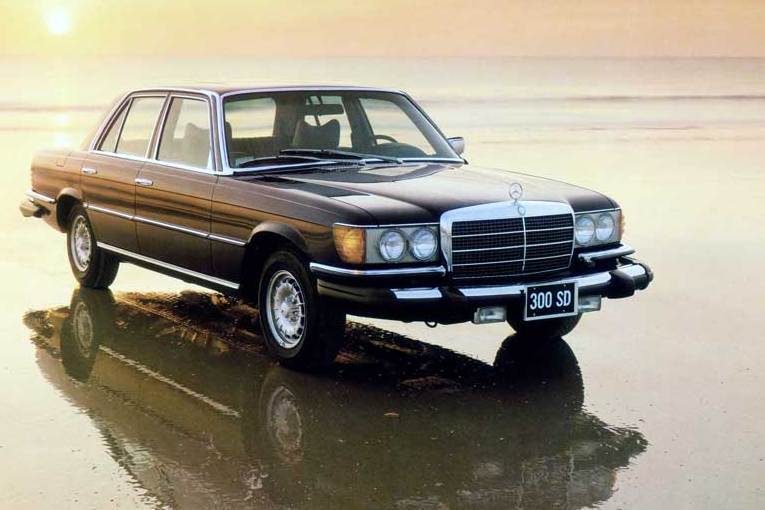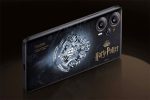A brand-new premium-class vehicle generation was presented to the public in September 1972. The first officially designated Mercedes-Benz S-Class – internal designation W 116 – replaced the W 108/109 series and was initially comprised of three models: the 280 S, 280 SE and 350 SE. The 280 S and 280 SE models featured the six-cylinder M 110 engine with dual overhead camshafts that had made its debut in the W 114. Six months later the S-Class saloon was also offered with the larger 4.5-litre V8 engine in parallel to the 450 SL and 450 SLC. At the same time the 450 SEL was introduced, its wheelbase lengthened by an extra 100 millimeters; as with its predecessor models, the additional space served to increase legroom in the rear. The long version was also available from November 1973 as a 350 SEL and from April 1974 as a 280 SEL.
One noteworthy engineering innovation first featured as standard in the 116-series saloons was the double-wishbone front suspension with zero-offset steering and anti-dive control, as tested originally in the C 111 experimental vehicle. This permitted further dynamic handling improvements. Rear suspension was essentially the same as the design that had by this stage been tried and tested over many years in the Stroke Eight models, and which was also in use in the 350 SL. The 4.5-litre models were fitted with a coupled-link axle.
In terms of passive safety too, the S-Class was at the forefront of engineering. The variety of safety design features integrated for the first time into the 350 SL were of course included without exception in the S-Class saloons. The fuel tank, for example, was no longer positioned in the rear end but above the rear axle for protection in case of accident; in the interior, maximum protection was offered by the heavily padded instrument panel, yielding or recessed switches and levers, and a four-spoke safety steering wheel with impact absorber and broad padded boss. The most significant improvement over the predecessor series was the even stronger safety passenger cell with stiffened roof-frame design, high-strength rigid roof and door pillars and reinforced doors. By controlling the deform-ability of front and rear end it was also possible to improve energy absorption considerably in the front and rear crumple zones.
Special wind deflectors on the A-pillars guaranteed good visibility. In wet conditions these served as channels for dirty water, keeping the side windows clean in bad weather. Other safety features included wrap-around turn indicator lamps that provided good visibility even from the sides, and large rear lights, which offered good resistance against soiling thanks to their ribbed surface profile.
In May 1975 the company presented the 450 SEL 6.9 – the new top model in the series and true successor to the Mercedes-Benz 300 SEL 6.3. The powerful 6.9-litre V8 engine, developed from the highly successful 6.3-litre unit, achieved an output of 210 kW and maximum torque of 56 mkg (549 Nm). The hydro-pneumatic suspension with self-levelling – featured for the first time in a Mercedes-Benz passenger car – guaranteed the utmost in ride comfort. Other special equipment included in the standard specification for the top-of-the-range model were the central locking system, air-conditioning and a headlamp wash/wipe system. As was the case with its direct predecessor, the 450 SEL 6.9 proved an immediate success; although it was more than twice as expensive as the 350 SE, a total of 7380 units were built during its four-and-a-half year production period.
Between November 1975 and February 1976 the direct fuel injection system in the 2.8-litre, 3.5-litre and 4.5-litre injection engines was converted to fall in line with more stringent emissions standards now in force in most European countries. The electronically controlled Bosch D-Jetronic was abandoned in favor of the newly developed mechanically controlled Bosch K-Jetronic. In all three cases conversion was achieved with only minor loss in output; at the same time, compression was slightly reduced in the 2.8-litre and 3.5-litre engines. For ease of maintenance these modifications also included breaker-less transistorized ignition and hydraulic valve clearance compensation for both V8 engines. As with the 2.8-litre injection engine, compression was also reduced in the carburetor engine, similarly causing a slight decrease in output.
Two years later, from April 1978, the original output was once again offered in all three models with injection engines. In contrast to the carburetor version, compression in the 2.8-litre injection unit was raised to its old value, and the previous output in the two V8 models was achieved largely by modifications to the exhaust system.
In May 1978 the model range of the 116 series was expanded even further. As the latest addition to the family, the 300 SD attracted just as much attention among connoisseurs as the 450 SEL 6.9 had done three years earlier – although it was positioned at the opposite end of the performance scale. For the first time in the history of this vehicle category, the new S-Class model was powered by a diesel engine. The 3.0-litre five-cylinder unit, that had proved so successful in the mid-range 240 D 3.0 and 300 D models, was given a turbocharger for its new role, enabling output to be increased to 85 kW.
Development of this unusual S-Class variant, which was offered exclusively in the USA and Canada, was begun with the aim of meeting the fuel consumption standards recently introduced by the US government. The most decisive factor here was the so-called Corporate Average Fuel Economy, an invention of the Carter administration, which denoted the average fuel consumption of all passenger car models in a manufacturer’s range. By extending the range to include conventional economical diesel models it was possible to bring the fleet’s average fuel consumption under the legal limit.
A technical innovation of ground-breaking significance was offered as a world exclusive in the S-Class saloons of the 116 series from the autumn of 1978: the anti-lock braking system (ABS), developed in collaboration with Bosch, which guaranteed a vehicle’s unrestricted steering response even under emergency braking and thus made a vital contribution to active safety. Today almost commonplace and available even in small cars, at the time of market launch ABS was seen as nothing short of sensational. Safety of a rather different nature was offered by the armored version of the 116 series. Protection design underwent further improvements based on the experience gained during development of the armored 280 SEL 3.5. Taking the eight-cylinder models as a whole – the 350 SE, 350 SEL, 450 SE and 450 SEL – a total of 292 units were built as armored vehicles for delivery to special customers, including many state institutions in Europe and overseas.
The successors to the first S-Class series – the W 126 models – were presented in September 1979 at the Frankfurt IAA. But that did not put an immediate end to the 116 series; production was gradually phased out for each model between April and September 1980. Of the 473,035 units built in this model series, the last vehicle to leave the Sindelfingen plant was a 300 SD model.









